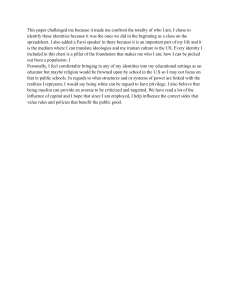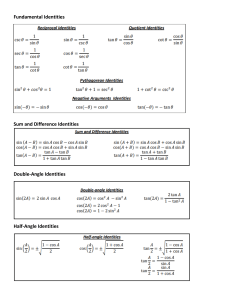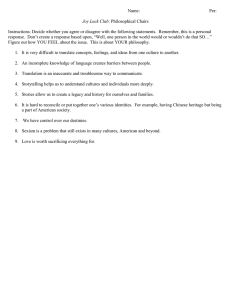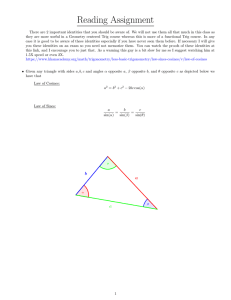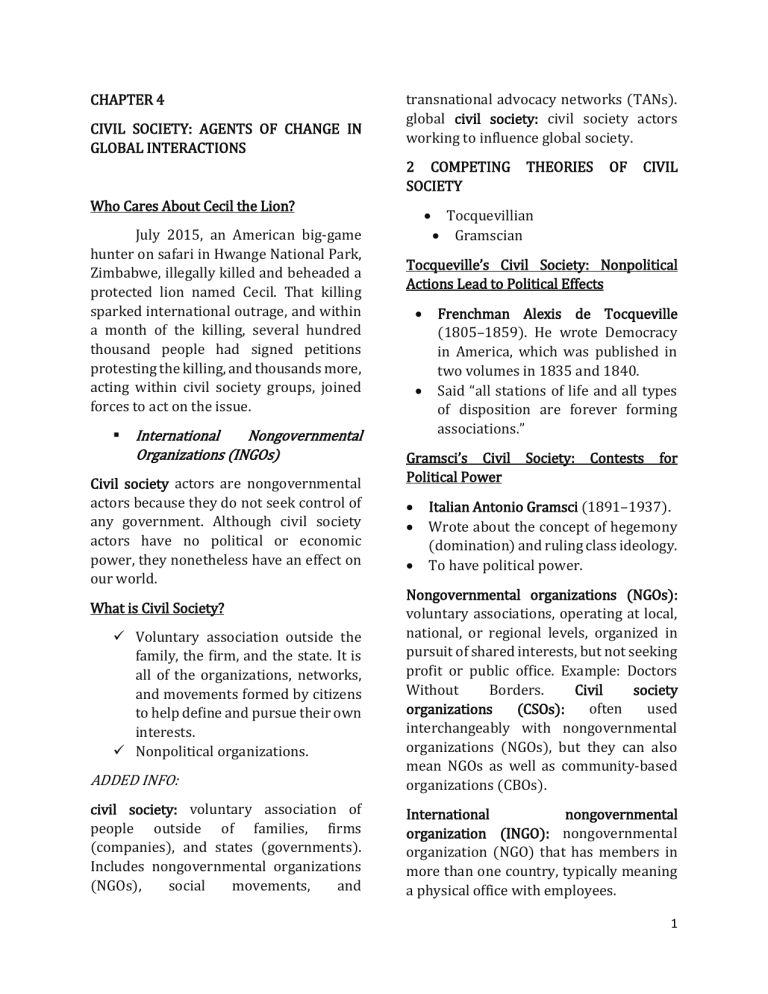
CHAPTER 4 CIVIL SOCIETY: AGENTS OF CHANGE IN GLOBAL INTERACTIONS transnational advocacy networks (TANs). global civil society: civil society actors working to influence global society. 2 COMPETING SOCIETY Who Cares About Cecil the Lion? July 2015, an American big-game hunter on safari in Hwange National Park, Zimbabwe, illegally killed and beheaded a protected lion named Cecil. That killing sparked international outrage, and within a month of the killing, several hundred thousand people had signed petitions protesting the killing, and thousands more, acting within civil society groups, joined forces to act on the issue. International Nongovernmental Organizations (INGOs) Civil society actors are nongovernmental actors because they do not seek control of any government. Although civil society actors have no political or economic power, they nonetheless have an effect on our world. THEORIES OF CIVIL Tocquevillian Gramscian Tocqueville’s Civil Society: Nonpolitical Actions Lead to Political Effects Frenchman Alexis de Tocqueville (1805–1859). He wrote Democracy in America, which was published in two volumes in 1835 and 1840. Said “all stations of life and all types of disposition are forever forming associations.” Gramsci’s Civil Society: Contests for Political Power Italian Antonio Gramsci (1891–1937). Wrote about the concept of hegemony (domination) and ruling class ideology. To have political power. ADDED INFO: Nongovernmental organizations (NGOs): voluntary associations, operating at local, national, or regional levels, organized in pursuit of shared interests, but not seeking profit or public office. Example: Doctors Without Borders. Civil society organizations (CSOs): often used interchangeably with nongovernmental organizations (NGOs), but they can also mean NGOs as well as community-based organizations (CBOs). civil society: voluntary association of people outside of families, firms (companies), and states (governments). Includes nongovernmental organizations (NGOs), social movements, and International nongovernmental organization (INGO): nongovernmental organization (NGO) that has members in more than one country, typically meaning a physical office with employees. What is Civil Society? Voluntary association outside the family, the firm, and the state. It is all of the organizations, networks, and movements formed by citizens to help define and pursue their own interests. Nonpolitical organizations. 1 Social movements: collective action for social change involving very loosely organized individuals, networks, and nongovernmental organizations (NGOs). Example: Black Lives Matter. TRANSNATIONAL ADVOCACY NETWORKS (TANs) Networks of activists, distinguishable largely by the centrality of principled ideas or values in motivating their formation. “Transnational. multicounty and usually multiregional. “ “Advocacy”. purpose of the activity is to advocate for some issue. It is not to make money or win office, but it is simply to advocate for some specific cause. “Network”. means they are loose networks of activists all over the world who come together on issues that matter to them, like human rights, women’s health, child labor, or land mines. Include think tanks, which are research organizations, often composed of academics, who publish highly specific policy research 202 that is intended to inform (or sway) opinion on an international issue. Transnational advocacy network (TAN): coalition or network of people—but not a formal organization— working for change, typically narrowly focused on a specific issue. LGBT RIGHTS AND TRANSNATIONAL ACTIVISM The International Gay and Lesbian Human Rights Commission (IGLHRC) is a U.S.based LGBT rights NGO (now called Out Right Action International). Its staff documents rights abuses, trains activists, and lobbies national and international governments. Anthropologist Ryan Thoreson studied how IGLHRC engaged with worldwide partners. Social Movements. ongoing, organized, collective action oriented toward social change. Social movements are informal networks of people who share an identity. Global markets. have increased the impact that societies make on one another, but they have also increased people’s ability to see this impact and to do something about it. Global governance. arrangement is a patchwork Three prominent theories that try to explain why IGOs have opened up to NGOs: Legitimacy Norms Functionalism HOW DOES CIVIL SOCIETY HAVE AN IMPACT? Norm Entrepreneurs: any actor that tries to create or change a norm. Many civil society actors are, or aim to be, norm entrepreneurs. FOUR TYPES OF ACTION Information Politics Symbolic Politics Leverage Politics Accountability Politics 2 Chapter 5 SOCIAL IDENTITIES AND CULTURE: SHAPING INTERACTIONS AT THE INDIVIDUAL AND SOCIETAL LEVELS What are Social Identities and Culture? When they talk about culture, social scientists typically mean the shared meanings, expected behaviors, ways of doing things, and customs in a particular society. culture: traditions, customs, and meanings that shape behavior and understanding To emphasize culture in how we look at the world is to recognize that ideas, norms, and expectations influence how people experience the world and how they behave. “Cultures are traditions and customs, transmitted through learning, that govern the beliefs and behavior of the people exposed to them. Social identity: understanding one’s self in relation to a group. Social identities are about who we are, about how we define our primary communities of belonging, and about defining who we are not. “Social identity is any social category in which an individual is eligible to be a member.” A social category is a collection of people who share some kind of characteristic. in-groups: people of the same group. (Worldview, family choices, value systems, food preferences) out-groups: people of a different group (global spread of information, importation of international tv, cinema, and social media, cheap food, global sports). GLOBAL INTERACTIONS AND FORCES IMPACT IDENTITY AND CULTURE Social identities and culture shape, and are shaped by, global interactions in myriad ways. FIFA (Fédération International de Football Association) THE UNITED NATIONS EDUCATIONAL, SCIENTIFIC, AND CULTURAL COUNCIL (UNESCO) It is an important world body that aims to shape and promote culture globally UNESCO tries to set agendas on culture globally. INFORMATION AND COMMUNICATIONS TECHNOLOGY (ICT). is a giant conduit for information, and culture and information are intricately linked? Because of advances in ICT, people all over the world can access information, ideas, songs, television shows, YouTube clips, and books at their fingertips. That intensifies cultural interactions in all kinds of ways whose effects are hard to foresee. Which Social Identities Matter? sports teams claim a strong pull 3 on people’s social identities around the world. RELIGIOUS IDENTITY Religious identity is also highly consequential. National Identity A nation is a large community of people who, believing they hold a common bond, make a claim to have a sovereign state of their own. national identity: social identity constituted by membership in a national group. GENDER IDENTITY Gender identity plays a critical role in international affairs. gender identity: social identity in which belonging is determined by gender difference Class Identity Nationalism Nationalism has two main meanings. Nationalism refers to the attitudes emotions that individuals experience in reference to their national identity. Nationalism: attitudes and emotions that individuals experience in reference to their national identity, or the desire for self-determination, the desire for a state of one’s own. A common way to refer to people is as “lower” class or as “upper” class, referring to the professions that they have and their overall wealth. Ethnic Identity Ethnicity is one of the most significant social categories within countries. John Hutchinson and Anthony Smith define an ethnic group as a named human population with myths of common ancestry, shared historical memories, one or more elements of common culture, a link with a homeland, and a sense of solidarity among at least some of its members. socio-economic, is a critical category for action. Socio-economic class refers to a grouping based primarily on economic status. Class identity helps locate individuals on the basis of how they would situate themselves, or how they could be objectively situated, in relationship to the economic system. Class identity: social identity in which belonging is determined by social class. WHY DO SOME SOCIAL IDENTITIES MATTER MORE THAN OTHERS? First, those identities that are “sticky” matter. Second, identities that are visible are particularly powerful. Third, those identities that have symbolic and emotional power are the ones that exercise the strongest 4 pull on people. SOCIAL IDENTITIES AND GLOBAL CHALLENGES Social identities are enormously consequential for how people act in the world and for how they see the world. Social identities shape how people imagine community; how they imagine community in turn shapes how they see their interests; and how they see their interests in turn shapes how people act in several important social and political ways. As a result, social identities are often critical for understanding the global challenges that this book underlines. Understanding Culture 1. Culture as a Worldview culture encompasses two main ideas in an international studies context. The first is an analytical concept that denotes, in general, a “worldview” within a society, organization, or social category. One of the most influential definitions in this tradition is from the anthropologist Clifford Geert. Geertz wrote that culture is “an historically transmitted pattern of meaning embodied in symbols. For Geertz, as for many others, culture connotes the idea of a system of meaning by which people make sense of their world. Culture shapes how people communicate, perpetuate, and develop knowledge and attitudes. In short, culture is like a prism, or mental map, that filters how people see and understand the world around them. 2. Culture and Stereotypes People’s values and opinions vary considerably in every society, and they change: That is to say, culture is neither deterministic nor static, nor does it operate only at a national level. 3. Culture as the Product of Human Intellectual and Artistic Activity The second broad concept of culture treats it as a catchall category to describe the intellectual and artistic activity in a society; this usage is arguably the most common. Culture here refers to that which humans make— that which distinguishes humans from other animals. 4. Culture and Global Challenges Culture and the Challenge of Globalization: Clash, Convergence, or Localization? 1. Clash of Cultures The first is the idea of a “clash” of civilizations or cultures. In this model, cultures are somewhat static; they represent distinctive blocs of values and beliefs that are, or potentially are, in conflict with each other. In an era of intensified global interactions, one prediction is that as different cultures come 5 together more frequently, so too will the collisions and confrontations be greater. 2. Convergence or Homogenization A second model of culture and international interactions is the idea of convergence or homogenization. The concept here is that globalization will flatten difference; one culture will dominate. In most applications of this model, the idea is that the most powerful cultures of the world will export their values, beliefs, and practices through their power in the media, business, and politics, and will extinguish other cultures in their path. 3. Localization they observe a much more nuanced process of cultural interaction and “localization,” the idea of adapting to local conditions and tastes. This is the third model of culture and international interactions. Scholars have developed numerous concepts to capture this process of global and local cultural interaction. One is the concept of “glocalization,” which suggests that globalized processes become localized. 6
